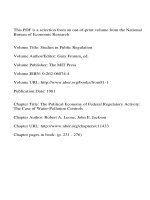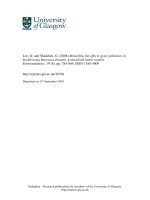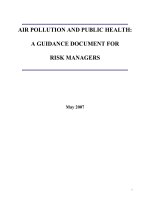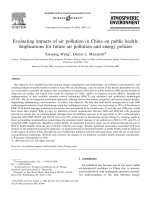Biostatistics in Public Health Using Stata
Bạn đang xem bản rút gọn của tài liệu. Xem và tải ngay bản đầy đủ của tài liệu tại đây (9.93 MB, 202 trang )
Striking a balance between theory, application, and programming, Biostatistics in
Public Health Using STATA is a user-friendly guide to applied statistical analysis in
public health using STATA version 14. The book supplies public health practitioners
and students with the opportunity to gain expertise in the application of statistics in
epidemiologic studies.
The book includes coverage of data description, graph construction, significance
tests, linear regression models, analysis of variance, categorical data analysis, logistic
regression model, Poisson regression model, survival analysis, analysis of correlated
data, and advanced programming in STATA.
Each chapter is based on one or more research problems linked to public health.
Additionally, every chapter includes exercise sets for practicing concepts and exercise
solutions for self or group study. Several examples are presented that illustrate the
applications of the statistical method in the health sciences using epidemiologic study
designs.
Presenting high-level statistics in an accessible manner across research fields in public
health, this book is suitable for use as a textbook for biostatistics and epidemiology
courses or for consulting the statistical applications in public health.
For readers new to STATA, the first three chapters should be read sequentially, as
they form the basis of an introductory course to this software.
an informa business
www.crcpress.com
6000 Broken Sound Parkway, NW
Suite 300, Boca Raton, FL 33487
711 Third Avenue
New York, NY 10017
2 Park Square, Milton Park
Abingdon, Oxon OX14 4RN, UK
K25609
ISBN: 978-1-4987-2199-8
90000
Biostatistics in Public Health Using STATA
The book shares the authors’ insights gathered through decades of collective experience
teaching in the academic programs of biostatistics and epidemiology. Maintaining a
focus on the application of statistics in public health, it facilitates a clear understanding
of the basic commands of STATA for reading and saving databases.
Suárez • Pérez
Nogueras • Moreno-Gorrín
Biostatistics / Public Health
Biostatistics in
Public Health
Using STATA
Erick L. Suárez
Cynthia M. Pérez
Graciela M. Nogueras
Camille Moreno-Gorrín
9 781498 721998
w w w.crcpress.com
K25609 mech rev.indd 1
2/16/16 9:13 AM
Biostatistics in
Public Health
Using STATA
This page intentionally left blank
Biostatistics in
Public Health
Using STATA
Erick L. Suárez
Cynthia M. Pérez
Graciela M. Nogueras
Camille Moreno-Gorrín
CRC Press
Taylor & Francis Group
6000 Broken Sound Parkway NW, Suite 300
Boca Raton, FL 33487-2742
© 2016 by Taylor & Francis Group, LLC
CRC Press is an imprint of Taylor & Francis Group, an Informa business
No claim to original U.S. Government works
Version Date: 20160201
International Standard Book Number-13: 978-1-4987-2202-5 (eBook - PDF)
This book contains information obtained from authentic and highly regarded sources. Reasonable
efforts have been made to publish reliable data and information, but the author and publisher cannot
assume responsibility for the validity of all materials or the consequences of their use. The authors and
publishers have attempted to trace the copyright holders of all material reproduced in this publication
and apologize to copyright holders if permission to publish in this form has not been obtained. If any
copyright material has not been acknowledged please write and let us know so we may rectify in any
future reprint.
Except as permitted under U.S. Copyright Law, no part of this book may be reprinted, reproduced,
transmitted, or utilized in any form by any electronic, mechanical, or other means, now known or
hereafter invented, including photocopying, microfilming, and recording, or in any information storage or retrieval system, without written permission from the publishers.
For permission to photocopy or use material electronically from this work, please access www.copyright.com ( or contact the Copyright Clearance Center, Inc. (CCC), 222
Rosewood Drive, Danvers, MA 01923, 978-750-8400. CCC is a not-for-profit organization that provides licenses and registration for a variety of users. For organizations that have been granted a photocopy license by the CCC, a separate system of payment has been arranged.
Trademark Notice: Product or corporate names may be trademarks or registered trademarks, and are
used only for identification and explanation without intent to infringe.
Visit the Taylor & Francis Web site at
and the CRC Press Web site at
To our loved ones
To those who have enlightened our path throughout their knowledge.
This page intentionally left blank
Contents
Preface ................................................................................................................xi
Acknowledgments ............................................................................................xiii
Authors .............................................................................................................. xv
1 Basic Commands ....................................................................................1
1.1
1.2
1.3
1.4
1.5
1.6
1.7
1.8
1.9
Introduction ....................................................................................1
Entering Stata ..................................................................................2
Taskbar ............................................................................................2
Help ................................................................................................3
Stata Working Directories ...............................................................4
Reading a Data File .........................................................................6
insheet Procedure .............................................................................7
Types of Files ...................................................................................7
Data Editor......................................................................................7
2 Data Description ..................................................................................11
2.1
2.2
2.3
2.4
2.5
2.6
2.7
2.8
2.9
2.10
2.11
2.12
Most Useful Commands ...............................................................11
list Command ................................................................................12
Mathematical and Logical Operators.............................................12
generate Command ........................................................................14
recode Command ...........................................................................15
drop Command .............................................................................16
replace Command ..........................................................................16
label Command .............................................................................16
summarize Command ...................................................................17
do-file Editor .................................................................................19
Descriptive Statistics and Graphs...................................................19
tabulate Command ........................................................................20
3 Graph Construction .............................................................................23
3.1
3.2
3.3
3.4
Introduction ..................................................................................23
Box Plot .........................................................................................23
Histogram .....................................................................................25
Bar Chart ......................................................................................25
vii
viii ◾
Contents
4 Significance Tests .................................................................................29
4.1
4.2
4.3
4.4
4.5
4.6
4.7
Introduction ..................................................................................29
Normality Test ..............................................................................31
Variance Homogeneity ..................................................................31
Student’s t-Test for Independent Samples .......................................33
Confidence Intervals for Testing the Null Hypothesis ...................35
Nonparametric Tests for Unpaired Groups ....................................35
Sample Size and Statistical Power ...................................................36
5 Linear Regression Models ....................................................................41
5.1
5.2
5.3
5.4
5.5
5.6
5.7
5.8
5.9
5.10
5.11
5.12
5.13
5.14
5.15
5.16
Introduction ..................................................................................41
Model Assumptions ...................................................................... 42
Parameter Estimation ....................................................................43
Hypothesis Testing ........................................................................43
Coefficient of Determination ........................................................ 44
Pearson Correlation Coefficient .....................................................45
Scatter Plot ................................................................................... 46
Running the Model .......................................................................47
Centering.......................................................................................47
Bootstrapping ................................................................................49
Multiple Linear Regression Model .................................................50
Partial Hypothesis .........................................................................52
Prediction ......................................................................................54
Polynomial Linear Regression Model ............................................55
Sample Size and Statistical Power ..................................................57
Considerations for the Assumptions of the Linear Regression Model.... 59
6 Analysis of Variance .............................................................................61
6.1
6.2
6.3
6.4
6.5
6.6
6.7
6.8
6.9
6.10
Introduction ..................................................................................61
Data Structure ...............................................................................62
Example for Fixed Effects ..............................................................62
Linear Model with Fixed Effects ....................................................63
Analysis of Variance with Fixed Effects ........................................ 64
Programming for ANOVA ............................................................65
Planned Comparisons (before Observing the Data).......................68
6.7.1
Comparison of Two Expected Values..............................68
6.7.2
Linear Contrast...............................................................69
Multiple Comparisons: Unplanned Comparisons ..........................70
Random Effects .............................................................................72
Other Measures Related to the Random Effects Model .................74
6.10.1 Covariance .....................................................................74
6.10.2 Variance and Its Components.........................................75
6.10.3 Intraclass Correlation Coefficient ...................................75
Contents
6.11
6.12
◾
ix
Example of a Random Effects Model.............................................75
Sample Size and Statistical Power ..................................................78
7 Categorical Data Analysis ....................................................................81
7.1
7.2
7.3
7.4
Introduction ..................................................................................81
Cohort Study .................................................................................82
Case-Control Study ...................................................................... 84
Sample Size and Statistical Power ..................................................86
8 Logistic Regression Model ...................................................................89
8.1
8.2
8.3
8.4
8.5
8.6
8.7
8.8
8.9
8.10
8.11
8.12
8.13
Model Definition ...........................................................................89
Parameter Estimation ................................................................... 90
Programming the Logistic Regression Model ................................91
8.3.1 Using glm..........................................................................92
8.3.2 Using logit ........................................................................92
8.3.3 Using logistic .....................................................................93
8.3.4 Using binreg......................................................................93
Alternative Database ......................................................................94
Estimating the Odds Ratio ............................................................95
Significance Tests ..........................................................................96
8.6.1 Likelihood Ratio Test .......................................................96
8.6.2 Wald Test .........................................................................96
Extension of the Logistic Regression Model...................................97
Adjusted OR and the Confounding Effect...................................100
Effect Modification......................................................................101
Prevalence Ratio ..........................................................................102
Nominal and Ordinal Outcomes .................................................103
Overdispersion.............................................................................109
Sample Size and Statistical Power ................................................109
9 Poisson Regression Model ..................................................................113
9.1
9.2
9.3
9.4
9.5
9.6
9.7
Model Definition .........................................................................113
Relative Risk ................................................................................ 114
Parameter Estimation .................................................................. 115
Example....................................................................................... 115
Programming the Poisson Regression Model ............................... 116
Assessing Interaction Terms ......................................................... 117
Overdispersion.............................................................................121
10 Survival Analysis ................................................................................123
10.1
10.2
10.3
10.4
Introduction ................................................................................123
Probability of Survival .................................................................126
Components of the Study Design ................................................126
Kaplan–Meier Method ................................................................127
x
◾
Contents
10.5
10.6
10.7
10.8
10.9
10.10
10.11
10.12
10.13
10.14
10.15
10.16
Programming of S(t) ..................................................................128
Hazard Function ........................................................................132
Relationship between S(t) and h(t) .............................................134
Cumulative Hazard Function ....................................................135
Median Survival Time and Percentiles .......................................136
Comparison of Survival Curves .................................................137
Proportional Hazards Assumption .............................................138
Significance Assessment .............................................................139
10.12.1 Log-Rank Test ..........................................................140
10.12.2 Wilcoxon–Gehan–Breslow Test ............................... 141
10.12.3 Tarone–Ware Test.....................................................142
Cox Proportional Hazards Model ..............................................143
Assessment of the Proportional Hazards Assumption................. 145
Survival Function Estimation Using the Cox Proportional
Hazards Model ..........................................................................146
Stratified Cox Proportional Hazards Model ...............................146
11 Analysis of Correlated Data ...............................................................149
11.1
11.2
11.3
11.4
11.5
11.6
Regression Models with Correlated Data ...................................149
Mixed Models ............................................................................154
Random Intercept ......................................................................156
Using the mixed and gllamm Commands with a Random
Intercept ..................................................................................... 157
Using the mixed Command with Random Intercept and Slope. ..161
Mixed Models in a Sampling Design .........................................163
12 Introduction to Advanced Programming in STATA ..........................167
12.1
12.2
12.3
12.4
12.5
12.6
12.7
12.8
12.9
12.10
12.11
Introduction ...............................................................................167
do-files .......................................................................................167
program Command ....................................................................168
Log Files.....................................................................................170
trace Command..........................................................................170
Delimiters ..................................................................................171
Indexing .....................................................................................172
Local Macros ............................................................................. 174
Scalars ........................................................................................175
Loops (foreach and forvalues) ...................................................... 176
Application of matrix and local Commands for Prevalence
Estimation .................................................................................179
References ....................................................................................................... 183
Index ................................................................................................................185
Preface
This book is intended to serve as a guide to applied statistical analysis in public
health using the Stata program. Our motivation for writing this book lies in our
years of experience teaching biostatistics and epidemiology, particularly in the academic programs of biostatistics and epidemiology. The academic material is usually covered in biostatistics courses at the master’s and doctoral levels at schools of
public health. The main focus of this book is the application of statistics in public health. Because of its user-friendliness, we used the Stata software package in
the creation of the database and the statistical analysis that will be seen herein.
This 12-chapter book can serve equally well as a textbook or as a source for consultation. Readers will be exposed to the following topics: Basic Commands, Data
Description, Graph Construction, Significance Tests, Linear Regression Models, Analysis
of Variance, Categorical Data Analysis, Logistic Regression Model, Poisson Regression
Model, Survival Analysis, Analysis of Correlated Data, and Advanced Programming
in Stata. Each chapter is based on one or more research problems linked to public
health. We have started with the assumption that the readers of this book have taken
at least a basic course in biostatistics and epidemiology. Further, for those readers
who are new to Stata, the first three chapters should be read sequentially, as they
form the basis of an introductory course to this software.
Erick L. Suárez
University of Puerto Rico
Cynthia M. Pérez
University of Puerto Rico
Graciela M. Nogueras
MD Anderson Cancer Center
Camille Moreno-Gorrín
University of Puerto Rico
xi
This page intentionally left blank
Acknowledgments
We thank Dr. Kenneth Hess, professor of biostatistics at MD Anderson Cancer
Center in Houston, Texas, for his kind comments and suggestions aimed at improving different aspects of this book. We also thank Bob Ritchie for his excellent work
in editing this book. We want to acknowledge the support we received from the
Department of Biostatistics and Epidemiology of the Graduate School of Public
Health, University of Puerto Rico, in the writing of this book. We are very grateful
to the many students—particularly Marc Machín and Kristy Zoé Vélez of the MPH
program in Biostatistics—who collaborated by reading material for this book.
This book would not have been possible without the financial support that
we received from the following grants: CA096297/CA096300 from the National
Cancer Institute of the National Institutes of Health and 2U54MD00758 from
the National Institute on Minority Health and Health Disparities of the National
Institutes of Health.
xiii
This page intentionally left blank
Authors
Erick L. Suárez is a professor of biostatistics in the Department of Biostatistics and
Epidemiology at the University of Puerto Rico Graduate School of Public Health.
He has more than 25 years of experience teaching biostatistics at the graduate level
and has co-authored more than 75 peer-reviewed publications in chronic and infectious diseases. Dr. Suárez has been a co-investigator of several NIH-funded grants
related to cancer, HPV, HCV, and diabetes. He has extensive experience in statistical consulting with biomedical researchers, particularly in the analysis of microarrays data in breast cancer.
Cynthia M. Pérez is a professor of epidemiology in the Department of Biostatistics
and Epidemiology at the University of Puerto Rico Graduate School of Public
Health. She has taught epidemiology and biostatistics for over 20 years. She has
also directed efforts in mentoring and training to public health and medical students at the University of Puerto Rico. She has been the principal investigator or
co-investigator of research grants in diverse areas of public health including diabetes,
metabolic syndrome, periodontal disease, viral hepatitis, and HPV infection. She is
the author or co-author of more than 75 peer-reviewed publications.
Graciela M. Nogueras is a statistical analyst at the University of Texas MD
Anderson Cancer Center in Houston, Texas. She is currently enrolled on the PhD
program in biostatistics at the University of Texas—Graduate School of Public
Health. She has co-authored more than 30 peer-reviewed publications. For the past
nine years, she has been performing statistical analyses for clinical and basic science
researchers. She has been assisting with the design of clinical trials and animal
research studies, performing sample size calculations, and writing the clinical trial
reports of clinical trial progress and interim analyses of efficacy and safety data to
the University of Texas MD Anderson Data and Safety Monitoring Board.
xv
xvi ◾
Authors
Camille Moreno-Gorrín is a graduate of the Master of Science Program in
Epidemiology at the University of Puerto Rico Graduate School of Public Health.
During her graduate studies, she was a research assistant at the Comprehensive
Cancer Center of the University of Puerto Rico where she co-authored several articles in biomedical journals. She also worked as a research coordinator for the HIV/
AIDS Surveillance System of the Puerto Rico Department of Health, where she
conducted research on intervention programs to link HIV patients to care.
Chapter 1
Basic Commands
Aim: Upon completing the chapter, the learner should be able to
understand the general form of the basic commands of Stata for reading and saving databases.
1.1 Introduction
Stata is a computer program designed to perform various statistical procedures.
Among the basic statistical procedures that can be performed are the following:
calculation of summary measures, construction of graphs, and frequency distribution using contingency tables. Furthermore, using Stata, you can perform parameter estimation in generalized linear models and survival analysis models using
uncorrelated and correlated data. The program also has the ability to perform arithmetic operations on matrices. Its ability to export and import databases in the Excel
format gives Stata great versatility. This program is regularly used in biostatistics
courses in public health schools in different countries. It is also often cited as one
of the main programs used for statistical analysis in scientific publications related
to public health research.
This chapter will provide an introduction to the Stata program, version 14.0.
We assume that readers of this book have a basic knowledge of both biostatistics
and epidemiology.
1
2
◾ Biostatistics in Public Health Using STATA
1.2 Entering Stata
After selecting the Stata icon on your computer, the program responds with five
windows (Figure 1.1), which have the following utilities:
1. Command: In this window the user can write or enter “commands” or
instructions to perform various operations with an active database. Not all
commands can be executed in this area; there is also a taskbar with executable
commands.
2. Results: This window shows the results obtained after the execution of the
commands introduced or requested via the taskbar.
3. Variables: In this window the variables of an active database are displayed. If
this window is blank, that is an indication that there is no active database.
4. Review: This window lists all the commands used during the current open
session of the program and allows them to be repeated without rewriting
them in the command area.
5. Properties: This window displays the properties of the user’s variables and dataset.
1.3 Taskbar
The taskbar provides common access to all windows-based program commands, such
as File, Edit, Data, Graphics, and Statistics; these options can be found at the upper part
of the main window. The most frequently used icon is the Data Editor icon, with which
Figure 1.1 Main Stata 14 window.
Basic Commands ◾ 3
Figure 1.2 Taskbar and icons.
it is possible to enter values and identify the variables in a given project. The Graphics
button provides access to the window used to generate different types of graphs. The
Statistics option allows the user to perform statistical mathematical operations through
the execution of the commands. Below the taskbar are icons that allow the user to open,
save, and print, along with icons that facilitate the observation of graphics (Figure 1.2).
1.4 Help
One of the most useful attributes of Stata is its support system, which allows the
user to find the commands and their ways of execution, according to that user’s
specific needs. The help menu can be accessed by clicking on the “New Viewer”
icon on the toolbar or by typing either help or the letter h in the command area
and following that with a keyword that represents the topic about which the user
requires more information (see Figure 1.3).
4
◾ Biostatistics in Public Health Using STATA
Figure 1.3 Help window.
For example, if we want to learn how to perform an analysis of variance
(ANOVA), we can use one of the following commands:
help anova
or
h anova
Upon entering those commands, a specific window for ANOVA will appear (see
Figure 1.4).
1.5 Stata Working Directories
When working with Stata, files and results can be saved to a specific directory, which
is defined during the installation instructions. For example, to view the working
directory for a project, enter the command pwd (path of the current working directory), and the following results will be displayed:
. pwd
/Users/Documents/students
Basic Commands ◾ 5
Figure 1.4
Help ANOVA.
It is important to keep the working files in a directory that is different from the
default directory that Stata assigns, because during the regular program updates
files located in the default directory may be removed.
To create a particular file, the mkdir and cd commands must be used to navigate to that directory again. The sequence of commands to create a directory is
as follows:
cd C:\
Navigate to the main directory of your hard drive or to
the location where you wish to create your home
directory
mkdir new_folder
Create a new working directory
cd new_folder
Navigate to the new working directory
To use Stata in the new working directory, you need to restart the program
and immediately move to the desired directory. For example, assuming that the
name of the working directory is “students” and assuming, as well, that this
6
◾ Biostatistics in Public Health Using STATA
directory is located in your computer’s Documents folder, the following will take
you to that folder:
cd “/Users/Documents/students”
1.6 Reading a Data File
After creating the working directory in which, outside the Stata program, we have
previously copied a data file (i.e., the file named “Cancer.dta”), we proceed to open
the file. This can be done in two different ways: using the command area or using
the icon on the toolbar. For the former, we would write the following command
sequence:
cd “C:\new_folder”
dir
use cancer
Command to navigate to the new working directory
Command to browse the contents of the folder
The use command indicates the name of the file that
will be used
For the latter, on the other hand, it is necessary to click
, the Open icon, and
browse the folder that contains the working file. The describe command can be
used to view the information contained in the data file, which might include the
number of observations, variables, and file size, among others, as shown below
(assuming that the active database being used contains the anthropometric measurements of 10 subjects):
describe
Output
. describe
Contains data
obs:
10
vars:
5
size:
200
----------------------------------------------------------------------------storage
display
value
variable name
type
format
label
variable label
----------------------------------------------------------------------------var1
float
%9.0g
var2
float
%9.0g
var3
float
%9.0g
var4
float
%9.0g
var5
float
%9.0g
-----------------------------------------------------------------------------
Basic Commands ◾ 7
1.7 insheet Procedure
Another way to read a database in Stata is to import existing databases created
in other formats. Delimited text files using the .txt (can be opened by most text
editors), .raw (a raw image file), and .csv (an MS Excel file) extensions can be
imported into Stata. The most commonly used is .csv, which, as indicated, is created using MS Excel. In Excel, you must save the data file using the .csv file extension instead of the .xls extension. When you have the data saved with .csv, you can
then proceed to use the insheet command in Stata:
insheet using “c:/data.csv”, replace
The replace option that has been placed after the comma (above) is used to
clear the program if another database was being used. Stata does not open
a database if there is another one that is already open. The clear command can
also be used in Stata to remove a database, therefore clearing the way to use a
new one.
1.8 Types of Files
Below is a list of the different types of archives that can be created in Stata; the lefthand column contains the file extensions that correspond to each archive.
.dta
data files
.do
command files
.ado
programs
.hlp
help files
.gph
graphs
.dct
dictionary files
1.9 Data Editor
In the Data Editor window, you can input data for the creation and identification of the study variables. One advantage of Stata’s data editor is its ability
to import databases built in Excel. This is done by the simple operation of selecting the entire database in Excel and copying and pasting it into the Stata data
editor.
8
◾ Biostatistics in Public Health Using STATA
Figure 1.5 Data Editor window.
To access the Data Editor window (Figure 1.5), click the “Edit” icon,
, on
the taskbar located in the main window.
At the beginning of the data entry process, the program automatically assigns a
name to the column that defines each variable (var1, var2, …, vark). This name can
be changed in the Variables Manager window after clicking the Data Editor icon,
using the box “Name” (Figure 1.6). To return to the main window of Stata, you
close or minimize the Data Editor window.
Constructing a user-friendly database requires that each variable be named in
such a way as to be easy to identify. This can be done using the “Label” box in the
properties window. When building a database, it is possible for the values assigned to
the variables to be represented by codes. The coding of the variables can be done using
the “Value Label” option. With this option you can assign numerical values to alphanumeric variables, thereby allowing better management of the database. This coding
can be done in the Variables Manager window. The steps to do this are as follows:
1. Click “Manage” in the Variables Manager window, and a new window appears
(Figure 1.7). Then click “Create Label” to assign each code a label.
2. After creating the value labels, return to the Variables Manager window, in
which you will be able to assign labels to each variable in the “Label” box (if they
were not assigned previously in the Properties window) (Figure 1.8).









